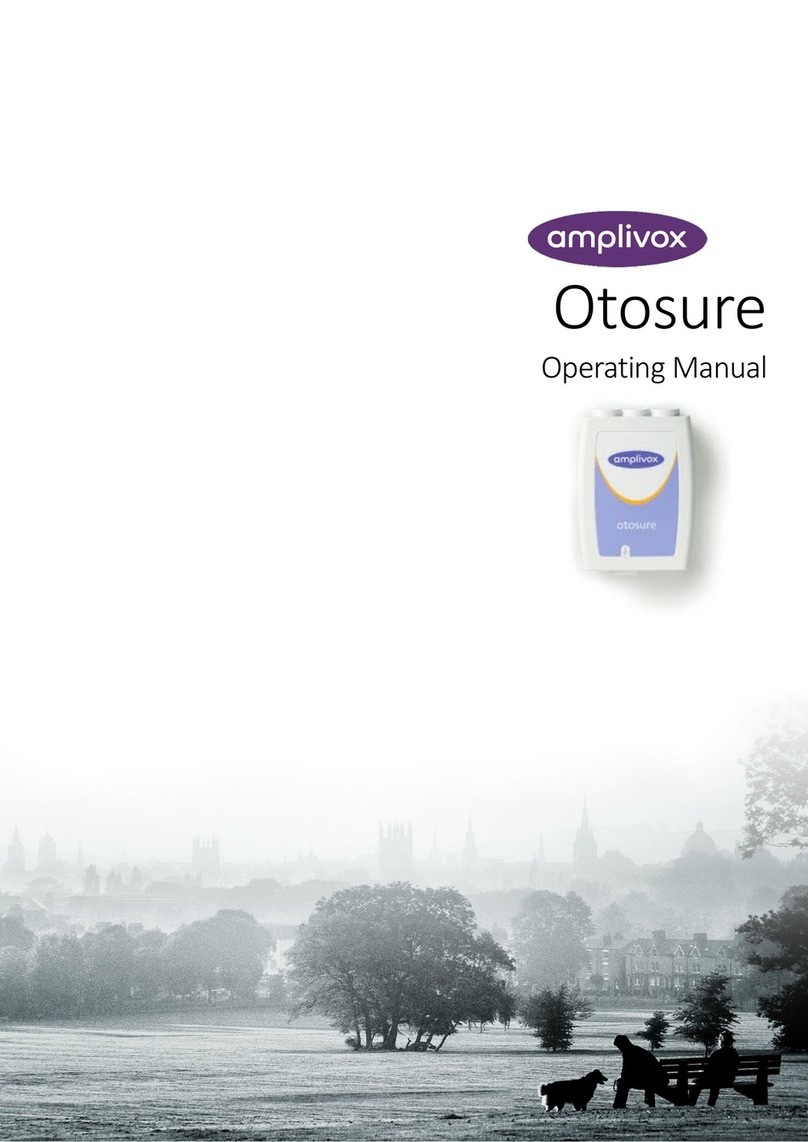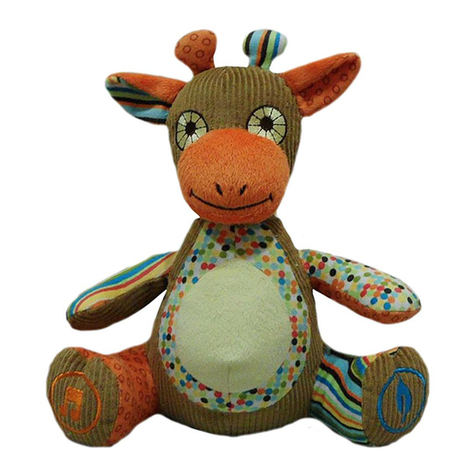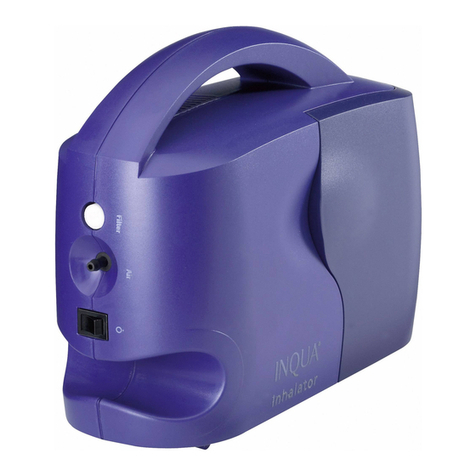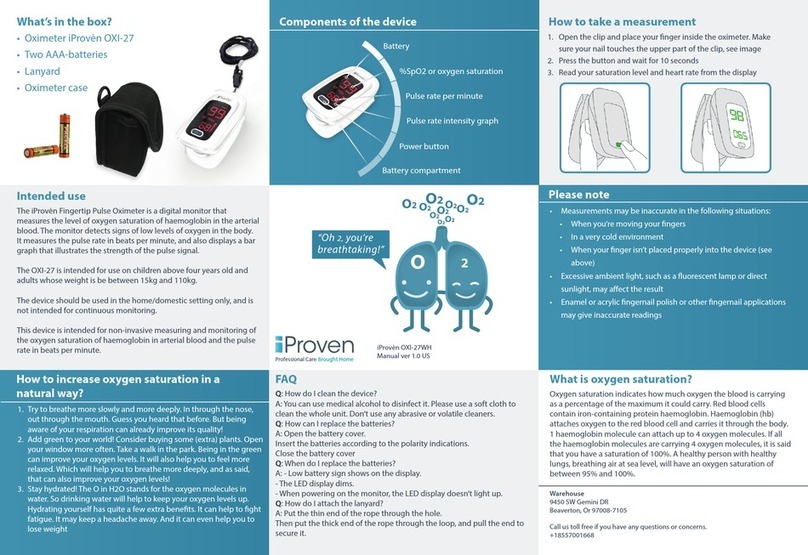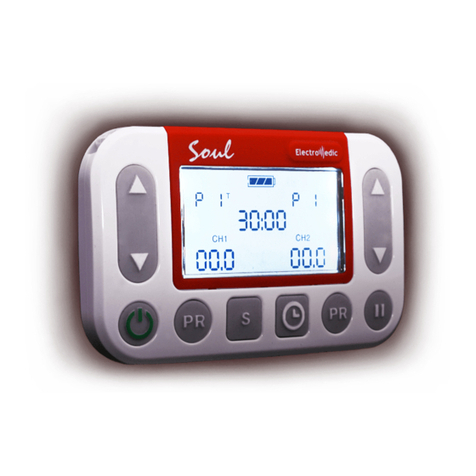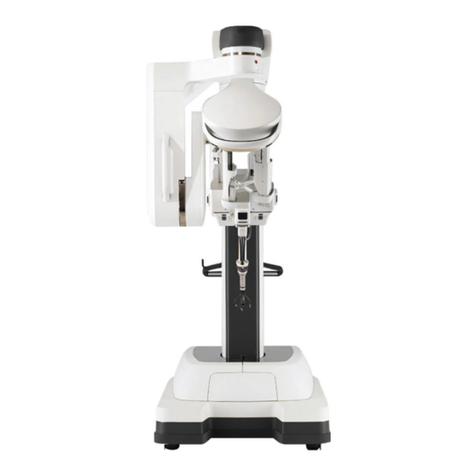ETView Vivasight Series User manual

Left-sided VivaSight-DL
For use by trained personnel only
By ETView
For use only with Ambu® aViewTM monitor
Instructions for Use


3
Instructions for use - For use by trained personnel only...........................................................................................4
Упътване за употреба - За употреба само от обучен персонал................................................................ 15
Návod k použití - Prostředek je určen pouze k použití zaškolenými osobami ....................................... 24
Brugsvejledning - Må kun anvendes af uddannet personale............................................................................. 32
Bedienungsanleitung - Nur zur Verwendung durch geschultes Personal...............................................39
Οδηγίες χρήσης - Για χρήση μόνο από κατάλληλα εκπαιδευμένο προσωπικό .....................................48
Instrucciones de Uso - para uso exclusivo de personal capacitado...............................................................57
Kasutusjuhised - Ainult väljaõppinud personalile kasutamiseks......................................................................65
Käyttöohjeet - Vain koulutetun henkilöstön käyttöön ............................................................................................72
Mode d'Emploi - Conçu pour du personnel formé uniquement.....................................................................80
Upute za uporabu - Uporaba je namijenjena samo obučenom osoblju...................................................88
Használati utasítás - Kizárólag szakképzett személyzet általi használatra................................................. 95
Istruzioni per l'uso - Per l'uso esclusivo da parte di personale addestrato............................................. 103
取扱説明書 - 必ず訓練を受けた担当者のみが使用すること.................................................................... 111
.................................................................................................119
Naudojimo instrukcijos - Prietaisas skirtas naudoti tik apmokytiems darbuotojams....................127
Lietošanas instrukcijas - Drīkst lietot tikai apmācīts personāls....................................................................... 134
Gebruiksaanwijzing - Alleen worden gebruikt door getrainde medewerkers...................................141
Bruksanvisning - Skal kun brukes av opplært personell........................................................................................149
Instrukcja obsługi -produkt może być używany wyłącznie przez przeszkolony personel.......156
Instruções de utilização - Para utilização exclusiva de pessoal qualificado ......................................... 164
Instrucțiuni de utilizare - destinat pentru utilizarea exclusiv de către personal instruit ..............172
Инструкция по эксплуатации - Для использования только специально
обученным персоналом.............................................................................................................................................................. 180
Návod na použitie - určené na použitie výlučne vyškoleným personálom.......................................... 189
Navodila za uporabo - le za usposobljeno osebje ....................................................................................................197
Användarinstruktioner - Uteslutande för användning av utbildad personal.....................................204
Kullanım talimatları - sadece eğiti mli personel tarafından kullanıma uygundur .............................211
使用说明 - 只能由经过培训的人员操作 .......................................................................................................................218
EN
BG
CS
DA
DE
EL
ES
ET
FI
FR
HR
HU
IT
JA
KO
LT
LV
NL
NO
PL
PT
RO
RU
SK
SL
SV
TR
ZH

4
ENGLISH
STERILE (ETO) unless package has
been opened or damaged.
DO NOT REUSE.
Federal (US) law restricts this device to
sale by or on the order of a physician.
DESCRIPTION
VivaSight-DL is a single-use, left-
sided, double-lumen cuffed PVC
endobronchial tube with an embedded
video imaging device and light source at
the distal end of the tracheal lumen, and
an integrated single use video/power
cable (adapter cable) with connector.
VivaSight-DL displays images of the
airway onto the Ambu® aViewTM monitor
for as long as the device remains in
place during intubation.
VivaSight-DL has two color-coded
low-pressure cuffs with corresponding
pilot balloons: clear cuff and balloon for
tracheal blocking; blue cuff and balloon
for bronchial blocking. Additionally,
for cleaning the imaging lens, the
VivaSight-DL has an injection port
leading to two lumens along the tube’s
wall, which opens at the distal end of
the imaging lens.
INDICATIONS FOR USE
The ETView VivaSight-DL System is
intended to isolate the left or right
lung of a patient for intensive care or
surgery, one lung ventilation or one
lung anesthesia.
The VivaSight-DL system is indicated
for verifying tube placement and
repositioning.
CONTRAINDICATIONS
Do not use laser equipment in the
immediate proximity of the VivaSight-DL.
Do not use VivaSight-DL for patients
with obstructions or stenosis in the left
main bronchus.
ACCESSORIES
Stylet.
WARNINGS
• VivaSight-DL is a single use
product. Do not reuse: After use,
handle and dispose a ccording
to local regulations for disposal
of infected medical devices.
Reuse of this single use product may
create a potential risk to the user.
Reprocessing, cleaning, disinfection
and sterilization may compromise
product characteristics which in turn
create an additional risk of physical
harm to or infection of the patient.
• Do not attempt to resterilize any
part of VivaSight-DL.
• Do not connect VivaSight-DL into any
device or electrical outlet other than
those supplied by ETView or Ambu.
• The intended performance of
the VivaSight-DL is reached only
with the disposable devices and a
ccessories provided or specified by
Ambu or ETView.
• VivaSight-DL is available in tube
sizes of 35 Fr; 37 Fr; 39 Fr and 41 Fr
(outer diameter - OD) and should be
used for patients who require one of
these sizes.
• Do not use the injection port for
suctioning the patient.
• The cuff pressure should normally
not exceed 25 cm H2O. Diffusion of
a nitrous oxide mixture, oxygen, or
air may either increase or decrease
the cuff pressure.
• Do not use the camera in the event
that inspired gas temperature
exceeds 34 °C for an artificially
ventilated patient.
• Do not overinflate the cuff.
Overinflation can result in tracheal/
bronchial damage, rupture of the
cuff with subsequent deflation, or
cuff distortion, which may lead to
airway blockage.
• Do not use the tube if the cuff is
damaged. Care must be taken
VIVASIGHTDL

5
to avoid damaging the cuff
during intubation.
• Do not use the tube if the cuff is
damaged. Various bony anatomical
structures such as teeth, or any
intubation aid with sharp surfaces
in the intubation path can damage
cuff intregrity. Care must be taken to
avoid damaging the thin-walled cuff
during intubation, which may result
in the patient requiring traumatic
extubation and reintubation.
• Both cuffs need to be completely
deflated prior to repositioning the
tube. Movement of the tube with
inflated cuffs may result in damage
to the cuff or in patient injury, which
may result in medical interventions.
• If the tube is lubricated prior to
intubation, it is essential to verify
that lubricant has not entered or
occluded the tube lumen or cuff-
filling system, thereby preventing
ventilation or damaging the cuff.
Ventilation and proper functioning
of the cuff may be impaired.
• Reliance on the graduated black
depth marks on the tube should
not substitute for expert judgment.
The user should be aware of
anatomical variations, including the
length of the airway. Intubation and
extubation should be performed
following currently accepted
medical techniques.
• VivaSight-DL’s location should be
verified every time the patient is
moved. Should extreme flexion
of the head (chin-to-chest) or
movement of the patient (e.g., to
lateral or prone positions) occur
after intubation, ensure that
VivaSight-DL remains in place.
• VivaSight-DL is for use in non-MRI
environment only.
• Do not use an intubation stylet other
than the stylet provided with the
VivaSight-DL.
• To ensure ventilation as intended,
be careful to fully align the arrows
on the Y-connector lumen and
rotator pointing either in the same
direction or opposite direction
depending on intended ventilation.
• Electronic equipment and the Viva-
Sight-DL system may affect the
normal function of each other. If the
VivaSight-DL system is used adjacent
to or stacked with other equipment,
observe and verify normal operation
of both the VivaSight-DL system and
the other electronic equipment prior to
using it. It may be necessary to adopt
procedures for mitigation, such as re-
orientation or relocation of the equip-
ment or shielding of the room in which
it is used. Consult the tables in appen-
dix 1 (English version) for guidance in
placing the VivaSight-DL system.
• Portable RF communications equip-
ment (including peripherals such as
antenna cables and external anten-
nas) should be used no closer than
30 cm (12 inches) to any part of the
system, including cables specified
by the manufacturer. Otherwise,
degradation of the performance of
this equipment could result.
• The VivaSight-DL is not to be
used when delivering flammable
anaesthetics to the patient. This
could potentially cause patient injury.
• Be careful to check whether the
image on the screen is a live image
or a recorded image.
• The surface temperature of the Viva-
Sight-DL is likely to reach above 43 °C
when the tube is placed outside the
patient. Therefore switch off the mon-
itor after the preuse test and switch
it back on immediately before use, to
prevent the risk of having an impact
on the tissue. The surface tempera-
ture on the Adapter Cable is likely to
reach between 41 °C and 43 °C.
• Prior to use, check that the pouch
seal is intact and there are no
impurities or damage on the
product such as rough surfaces,
sharp edges or protrusions which
may harm the patient.

6
ENGLISH
CAUTIONS
• Use of HF equipment in the
immediate proximity of the
VivaSight-DL may lead to impaired
image quality.
• Adapter Cable and connectors shall
be kept away from patient face to
avoid facial harm.
• VivaSight-DL is intended for use by
trained personnel only.
• Use the same size VivaSight–DL
as the required standard tube size.
Expert clinical judgment should
be used in choosing the suitable
tracheal tube size for each patient.
• Insert the stylet from the bronchial
side of the tube only.
• Before use, always check for
compatibility between the
VivaSight-DL and the external
instruments (e.g. bronchoscope,
and suction catheter).
• Do not immerse the tube in liquid.
• The use of lidocaine topical
aerosols has been associated with
the formation of pinholes in PVC
cuffs*. To prevent cuff leaks, expert
clinical judgment is required when
using lidocaine topical aerosols.
• Use only water-soluble lubricants.
Other lubricants might affect the
cuffs.
• Avoid applying lubricants to the
front of the camera or the inside
of the tube, due to risk of affecting
ventilation.
• Use a cuff pressure gauge to help
monitor and adjust the cuff pressure.
Inflation of the cuff by “feel” alone or
by using a measured volume of air is
not recommended as resistance is
an unreliable guide during inflation.
• Syringes, stopcocks or other devices
should not be left in the inflation
system for an extended period.
• When connecting the Y-Connector,
there is no need to remove
the standard connectors from
VivaSight-DL.
• To ensure secure placement once
the connector or the Y-connector
has been loosened or removed, the
connector or the Y-connector and
the corresponding part of the tube
shall be cleaned with ethanol prior
to reconnecting the connector or
the Y-connector.
• Use of a lubricant solution to
ease the insertion of the 15 mm
connectors is not recommended
as it may contribute to a ccidental
disconnection.
• Do not connect VivaSight-DL to any
external monitor equipment other
than aView.
*Jayasuriya KD, Watson WF: “P.V.C.
cuffs and Lidocaine-based aerosol”;
Br J Anaesth. 1981 Dec; 53 (12): 1368.
COMPATIBILITY
When VivaSight-DL is used
with external instruments (e.g.
bronchoscope, suction catheter), use
the following table of VivaSight-DL
effective inside diameter (defined by
ISO 16628) measurements as guidance
for choosing the appropriate diameter
of the external instrument that will be
inserted through VivaSight-DL.
PRODUCT Effective Inside
Diameter
VivaSight-DL 35 Fr 4.0 mm
VivaSight-DL 37 Fr 4.2 mm
VivaSight-DL 39 Fr 4.8 mm
VivaSight-DL 41 Fr 5.0 mm
YCONNECTOR OPERATION
Make sure to connect the blue tube of
the Y-connector to the blue bronchial
tube of the VivaSight-DL and the clear
tube of the Y-connector to the clear
tracheal tube of the VivaSight-DL.

7
• The Y-connector has an arrow print-
ed on both the tracheal and the bron-
chial lumen indicating the flow of air.
• An identical arrow is printed on the
rotator connected to each of the two
lumens.
• When the rotator arrow is pointing
in the same direction as the arrow
printed on the lumen, the lumen is
open for ventilation.
• In order to close the lumen for
ventilation, turn the rotator 180°
degrees until the arrows are
pointing in the opposite direction.
STORAGE AND TRANSPORTATION
• Store and transport VivaSight-DL
at temperatures between 0 °C and
42 °C, relative humidity between
10-100% and atmospheric pressure
between 80-109 kPa.
• Store in a dry, cool and dark place.
ADVERSE EVENTS
Adverse events associated with the
use of VivaSight-DL are the same
as those of standard double-lumen
endobronchial tubes. The most
common are: laryngospasm; vocal
cord paralysis; injuries to lips, gums,
tongue, teeth; and aspiration of gastric
contents. Consult scientific literature for
specific adverse reaction information.
Adverse events associated with use of
standard double-lumen endobronchial
tubes, are fracture or dislocation of
the cervical spine, endobronchial or
esophageal intubation, perforation
of the trachea or esophagus, failed
intubation, tube dislocation and
misplacement of the bronchial tube.
TECHNICAL SPECIFICATIONS
The VivaSight-DL is an electrical safety
defibrillation-proof type BF applied part.
• Imaging sensor: CMOS
• Resolution: CIF 320 x 240
• Video format: NTSC Composite
Video Baseband Signal (CVBS)
• Light source: 2 LEDs (integrated)
• FOV: Horizontal ~76°, Vertical ~56°,
Diagonal ~100°
• Focusing range: 12 mm-60 mm
• Power: up to 36 mA @ DC 5V
• Push VivaSight-EB into VivaSight-SL
or equivalent.
• Operating ambient temperature:
10-37 °C (50-98 °F)
• Operating relative humidity: 30-75%
• Operating atmospheric pressure:
80-109 kPa
• Operating altitude: ≤2000 m
INTUBATION RECOMMENDATIONS
Intubation with VivaSight-DL is
performed a ccording to currently
accepted medical techniques.
The tube position should be inside
the trachea and inserted into the left
main bronchus.
• Laryngoscope: Use of laryngoscope
for intubation of VivaSight-DL.
• Stylet: The a ccompanying stylet
is used to make VivaSight-DL
more rigid, for use with or without
laryngoscope.
• Oral: Approved for oral intubation
procedures.
PREINTUBATION PREPARATION
CHOOSING VIVASIGHTDL SIZE
• Use the same size VivaSight-DL as
standard required double-lumen
endobronchial tube size.
• Use expert clinical judgment when
choosing tracheal tube size for
each patient.

8
ENGLISH
CONNECTING THE TUBE,
VERIFICATION STEPS
& PREPARATION FOR
INTUBATION
1. Connect VivaSight-DL to the single
use adapter cable. Be careful to align
the white arrow on the single use
adapter cable with the arrow on the
VivaSight-DL tube round connector.
2. Connect the single use adapter
cable to the aViewTM monitor, be
careful to align the arrow on the
cable with the arrow indicator on
the aViewTM monitor. Verify that all
electrical connections are stable
and secure. Refer to aViewTM
monitor instructions for use.
3. Press the power button on top of
the aViewTM monitor for at least one
second until a live image appears.
Refer to Ambu® aViewTM monitor
instructions for use. The aViewTM
user interface will be ready after
approximately one minute, when the
hourglass symbol disappears.
4. Check that the two LEDs at the tip
of the tube are illuminated. If they
are not illuminated, replace the tube
with another.
5. Verify that there is a stable image
on the aViewTM monitor (projected
from the tip of VivaSight-DL). Then
turn off the monitor again until
immediately prior to intubation.
6. Test the cuffs for integrity by inflating
and deflating them completely.
7. Become familiar with the feel of the
blue and clear pilot balloons.
8. If applicable, verify that external
instruments of appropriate size can
be passed through the VivaSight-
DL without resistance. There is no
guarantee that instruments selected
solely using the effective inside
diameter will be compatible in
combination with the VivaSight-DL.
9. Induce anesthesia, as per protocol.
10. Suction the oral cavity and airway
area before inserting VivaSight-DL.
11. Prepare the patient, and lubricate
the tube (if needed), avoiding the
area around the camera lens at the
distal end of VivaSight-DL.
12. Intubate the patient and remove the
stylet. In case of obstructed or ob-
scured view, see “Cleaning the Lens”.
INTUBATION TECHNIQUE WITH
VIVASIGHTDL
1. Advance the VivaSight-DL bronchial
tube through the vocal cords with
the tip facing upward (figure 1).
Vocal cords
Bronchial cuff
[ figure 1 ]
2. At the proximal portion of the tube,
the bronchial arm of the tube will be
positioned above the tracheal arm
(figure 2).
3. When the tip passes the vocal
cords, and before the camera
passes it, turn the tube 90 degrees
counterclockwise until the camera
on the tube is facing up pointing
towards the vocal cords (figure 3).
In this position, the tube passes
through the vocal cords with the
camera on the superior portion of
the tube (figure 3).
Tracheal cuff
Camera
Rotate 90°
counter
clockwise.
Bronchial cuff
[ figure 2 ]
Bronchial cuff
Tracheal cuff
Camera
[ figure 3 ]

9
4. When the camera passes the vocal
cords, advance the tube further until
final positioning, without additional
tube maneuvering. When the tube is
in place, the proximal portion of the
bronchial arm will be horizontal and
on the left side (figure 4).
When required, use a video
laryngoscope to assist with correct
intubation with VivaSight-DL.
DEPTH SCALING
Note: Suggested depth is 2 cm to 3 cm
above the main carina. Keep in mind
that VivaSight-DL’s electronic wire is
outside the protective lumen at 28 cm
to 30 cm.
Like with most intubation tubes, a
series of depth marks appear on the
side of VivaSight-DL.
Depth marks range from 25 cm to
31 cm, in 2 cm increments.
To determine a specific depth, gauge
from the carina:
1. Insert VivaSight-DL’s camera up to
the depth of the carina.
2. Look at VivaSight-DL’s depth marks
on the side of the tube.
3. Pull VivaSight-DL back from the
carina to the desired depth.
VISIBILITY DURING
PROCEDURE
In the unlikely event that the image
is not shown during a procedure,
disconnect the VivaSight-DL from the
single use adapter cable to the aViewTM
monitor and continue to use VivaSight-
DL as a standard airway tube.
Do not attempt to fix the connection
or replace the monitor. Turn off the
aViewTM monitor and dispose of the
single use adapter cable.
CLEANING THE LENS
If VivaSight-DL’s lens becomes soiled
or obscured by secretions, it can be
cleaned by injecting air, prescribed
liquid medications, or saline, where
permitted by institutional policy, into
the injection port of the rinsing tube.
Recommended lens cleaning method:
1. Inject 20 cc air into the injection
tube port (RED), and then check
image clarity.
2. If the image is not sufficiently clear,
connect 10 cc syringe filled with
2 cc of Saline, to the flushing port
and push the plunger. Perform this
step twice (total of 4 cc of Saline).
3. Fill a 10 cc syringe with 5-10 cc of
air, connect it to the flushing port
and push the plunger. Perform this
step twice.
4. Connect an empty 10 cc syringe,
to the flushing port and suck the
Saline. Perform this step twice.
ADDITIONAL NOTES
• Continuous viewing of the airway
enables real-time verification of the
tube and the bronchial cuff position,
early detection of adverse airway
events, and secretion management
under visual guidance.
• Validation: During static situations
where VivaSight-DL is in place,
and the patient is not being
moved, validation that the system
Tracheal cuff
[ figure 4 ]
11. Prepare the patient, and lubricate
the tube (if needed), avoiding the
area around the camera lens at the
distal end of VivaSight-DL.
12. Intubate the patient and remove the
stylet. In case of obstructed or ob-
scured view, see “Cleaning the Lens”.
INTUBATION TECHNIQUE WITH
VIVASIGHTDL
1. Advance the VivaSight-DL bronchial
tube through the vocal cords with
the tip facing upward (figure 1).
Vocal cords
Bronchial cuff
[ figure 1 ]
2. At the proximal portion of the tube,
the bronchial arm of the tube will be
positioned above the tracheal arm
(figure 2).
3. When the tip passes the vocal
cords, and before the camera
passes it, turn the tube 90 degrees
counterclockwise until the camera
on the tube is facing up pointing
towards the vocal cords (figure 3).
In this position, the tube passes
through the vocal cords with the
camera on the superior portion of
the tube (figure 3).
Tracheal cuff
Camera
Rotate 90°
counter
clockwise.
Bronchial cuff
[ figure 2 ]
Bronchial cuff
Tracheal cuff
Camera
[ figure 3 ]

10
ENGLISH
is operating must be performed
periodically by observing breathing
movements and cardiac pumping
movement in the image on the
aViewTM monitor.
• The device usage time function on
the aViewTM monitor is not available
for VivaSight-DL. For this device,
the device usage time will always
display “00:00:00”. This will not
affect the functioning of the system.
EXTUBATION
• Deflate the tracheal and endobron-
chial cuffs completely, as per protocol.
• Extubation is performed slowly,
while examining the airway on
the aViewTM monitor one last time
(document or record, as necessary).
DISCONNECTING VIVASIGHTDL
1. Disconnect the single use adapter
cable from the aViewTM monitor.
2. Turn off the aViewTM monitor by
pressing the power button for at
least two seconds.
DISPOSAL
Discard the single use VivaSight-DL
tube, Y-connector, stylet and adapter
cable in a suitable biohazard receptacle
in a ccordance with local regulations.
For disposal instructions for the
aViewTM monitor, refer to aViewTM
monitor instructions for use.
MANUFACTURED BY:
ETView Ltd.
Catom 2 Street
Misgav Business Park
M.P. Misgav 2017900, Israel
www.etview.com
LB10097 REV03
Manufacture
Date
Expiry
Date
Consult instructions for use
Do not use if package
is damaged
Do not reuse
Sterilized Using
Ethylene Oxide
Non-sterile (single use
adapter cable only)
US Federal law restricts this
device to sale by or on the
order of a physician
Defibrillation-proof type BF
applied part
This product is
not made with phthalates
Temperature for
transportation and storage
100%
Humidity for transportation
and storage
109kPa
Pressure for transportation
and storage
STERILIZE
REF LOT
Manufacturer
EC REP Authorized Representative
in the European Community
Waste Bin Symbol
This product is not made
with natural rubber latex
REF
Reference Number
Lot Number, Batch Code
Caution

11
Appendix 1. Electromagnetic Compatibility
Like other electrical medical equipment the system requires special precautions
to ensure electromagnetic compatibility with other electrical medical devices.
To ensure electromagnetic compatibility (EMC) the system must be installed and
operated a ccording to the EMC information provided in this manual.
The system has been designed and tested to comply with IEC 60601-1-2
requirements for EMC with other devices.
Guidance and manufacturer’s declaration
- electromagnetic immunity
The system is intended for use in the electromagnetic environment specified
below. The customer or the user of the system should assure that it is used in
such an environment.
Emission Test Compliance Electromagnetic Environment
Guidance
RF emission CISPR 11 Group 1 The system use RF energy only for
its internal function. Therefore, its
RF emissions are very low and are
not likely to cause any interference
in nearby electronic equipment.
RF emission CISPR 11 Class B The system is suitable for use in all
establishments, including domestic
establishments and those directly
connected to the public low-
voltage power supply network
that supplies buildings used for
domestic purposes.
Harmonic emission IEC/EN
61000-3-2
Not
applicable
Voltage fluctuations /
flicker emissions IEC/EN
61000-3-3
Complies

12
ENGLISH
Guidance and manufacturer’s declaration
- electromagnetic immunity
The system is intended for use in the electromagnetic environment specified
below. The customer or the user of the system should assure that it is used in
such an environment.
Immunity Test IEC 60601-1-2
test level Compliance
Level Electromagnetic
environment -
guidance
Electrostatic
discharge (ESD)
IEC 61000-4-2
+/- 8 kV contact
+/- 2, 4, 8, 15
kV air
+/- 8 kV contact
+/- 2, 4, 8, 15
kV air
If floors are covered
with synthetic
material the relative
humidity shall be
least 30%.
Electrical fast
transient / burst
IEC 61000-4-4
+/- 2 kV for mains
supply lines
+/- 1 kV for input /
output lines
+/- 2 kV mains
supply lines
N/A
Mains power quality
shall be that of a
typical commercial or
hospital environment.
Surge
IEC 61000-4-5
+/- 0.5, 1 kV
line(s) to line(s)
+/- 0.5, 1, 2 kV
line(s) to earth
+/- 0.5, 1 kV
line(s) to line(s),
mains supply
+/- 0.5, 1, 2 kV
line(s) to earth,
mains supply
Mains power quality
shall be that of a
typical commercial or
hospital environment.
Voltage Dips,
short interruptions
and voltage
variations on
power supply
input lines
IEC 61000-4-11
0% Ut
(100% dip in Ut)
for 0.5 cycle at
8 angels
100% reduction
0.5 period at
8 angels
Mains power quality
shall be that of a
typical commercial or
hospital environment.
If the use of the
system requires
continued operation
during power
mains interruptions
the system can
be powered
by the built in
rechargeable battery.
0% Ut
(100% dip in Ut)
for 1 cycle
100% reduction
for 1 period
70% Ut
(30% dip in Ut)
for 25 cycles
30% reduction
for 25 periods
0% Ut
(100% dip in Ut)
for 5 sec.
100% reduction
for 5 sec.
Power frequency
(50/60 Hz)
magnetic field
IEC 61000-4-8
30 A/m 30 A/m Power frequency
magnetic fields
should be at levels
characteristic of a
typical location in a
typical commercial or
hospital environment.
NOTE: Ut is the a.c. mains voltage prior to application of the test level.

13
Guidance and manufacturer’s declaration
- electromagnetic immunity
The system is intended for use in the electromagnetic environment specified below.
The customer or the user of the system should assure that it is used in such an
environment.
Immunity
test IEC 60601-1-2
test level Compliance
level Electromagnetic environment
- guidance
Conducted
Radio
Frequency
IEC 61000-
4-6
3 V RMS
0,15 MHz -
80 MHz
6 V RMS
in ISM bands
80% AM at
1 kHz
3 V RMS
0,15 MHz -
80 MHz
6 V RMS
in ISM bands
80% AM at
1 kHz
Portable and mobile RF
communications equipment
should be used no closer to any
part of the system, including its
cables, than the recommended
separation distance calculated
from the equation applicable
to the frequency of the
transmitter.
Recommended separation
distance
d
= 1.17√
P
d
= 1.17√
P
80 MHz to 800 MHz
d
= 2.33√
P
800 MHz to 2.7
GHz
Where
P
is the maximum output
power rating of the transmitter
in watts (W) a ccording to
the transmitter manufacturer
and d is the recommended
separation distance in metres
(m).
Field strengths from fixed RF
transmitters, as determined
by an electromagnetic site
survey, a) should be less than
the compliance level in each
frequency range b).
Interference may occur in the
vicinity of equipment marked
with the following symbol.
Radiated
Radio
Frequency
IEC 61000-
4-3
3 V/m
80-2700 MHz
80% AM at
1 kHz
Additional
proximity
field test
frequencies
and levels a
ccording to
60601-1-2
table 9
3 V/m
80-2700 MHz
80% AM at
1 kHz
Additional
proximity
field test
frequencies
and levels a
ccording to
60601-1-2
table 9
NOTE 1: At 80 MHz, the higher frequency range applies.
NOTE 2: These guidelines may not apply in all situations. Electromagnetic
propagation is affected by absorption and reflection from structures,
objects and people.

14
ENGLISH
a) Field strengths from fixed transmitters, such as base stations for radio (celluar/
cordless) telephones and land mobile radios, amateur radio, AM and FM radio
broadcast, and TV broadcast, cannot be predicted theoretically with a ccuracy.
To assess the electromagnetic environment due to fixed RF transmitters, an
electromagnetic site survey shall be considered. If the measured field strength in
the location in which the system is used exceeds the applicable RF compliance
level above, the system shall be observed to verify normal operation. If abnormal
performance is observed, additional measures may be necessary, such as
reorienting or relocating the system.
b) Over the frequency range 150 kHz to 80 MHz, field strengths shall be less
than 3 V/m.
Recommended Separation Distances Between Portable and
Mobile RF Communication Equipment and system
The system is intended for use in an electromagnetic environment in which
radiated RF disturbances are controlled. The user of the system can help prevent
electromagnetic interference by maintaining a minimum distance between
portable and mobile RF communications equipment (transmitters and the
system as recommended below, a ccording to the maximum output power of the
communication equipment.
Rated maximum
output power (W)
of transmitter
Separation distance (m) a ccording to
frequency of transmitter
150 kHZ to
80 MHz
d = 1.17√P
80 MHz to
800 MHZ
d = 1.17√P
800 MHz to
2.7 GHz
d = 2.33√P
0.01 0.12 m 0.12 m 0.23 m
0.1 0.37 m 0.37 m 0.74 m
1 1.17 m 1.17 m 2.33 m
10 3.70 m 3.70 m 7.37 m
100 11.7 m 11.7 m 23.3 m
For transmitters rated at a maximum output power not listed above, the
recommended separation distance (d) in meters (m) can be estimated using the
equation applicable to the frequency of the transmitter, where P is the maximum
output power rating of the transmitter in watts (W) a ccording to the transmitter
manufacturer.
NOTE 1: At 80 MHz and 800 MHz, the separation distance for the higher frequency
range applies.
NOTE 2: These guidelines may not apply in all situations. Electromagnetic
propagation is affected by absorption and reflection from structures,
objects and people.

15
СТЕРИЛЕН (ETO), ако опаковката
не е отворена или повредена.
ДА НЕ СЕ ИЗПОЛЗВА ПОВТОРНО.
Федерално законодателство (на
САЩ) ограничава продажбата на
това устройство от или по предписа-
ние на лекар.
ОПИСАНИЕ
VivaSight-DL е лява, с двоен лумен,
PVC ендобронхиална тръба с ман-
шон за еднократна употреба с вгра-
дено устройство за получаване на
видеообраз и светлинен източник в
дисталния край на трахеалния лумен
и вграден видео/захранващ кабел
(адапторен кабел) за еднократна
употреба с конектор. VivaSight-DL
показва изображения от дихателни-
те пътища на монитор Ambu® aViewTM
докато устройството остава на мяс-
тото по време на интубация.
VivaSight-DL има два цветно коди-
рани маншона за ниско налягане
със съответните пилотни балони:
прозрачен маншон и балон за трахе-
ален блокаж; син маншон и балон
за бронхиален блокаж. Освен това
за почистване на визуализиращите
лещи VivaSight-DL има порт за ин-
жектиране, водещ към двата лумена
по протежение на стената на тръба-
та, който се отваря в дисталния край
на визуализиращите лещи.
ПОКАЗАНИЯ ЗА УПОТРЕБА
Системата VivaSight-DL на ETView е
предназначена за изолиране на ле-
вия или десния бял дроб на пациент
за интензивно лечение или хирур-
гична операция, за вентилация на
единия дроб или за анестезия на
единия дроб.
Системата VivaSight-DL е предназ-
начена за верифициране на поста-
вянето на тръба и за нейното пре-
местване.
ПРОТИВОПОКАЗАНИЯ
Да не се използва лазерно оборуд-
ване в непосредствена близост на
VivaSight-DL.
Да не се използва VivaSight-DL при
пациенти с обструкции или стенози в
левия главен бронх.
АКСЕСОАРИ
Стилет.
ПРЕДУПРЕЖДЕНИЯ
• VivaSight-DL е продукт за едно-
кратна употреба. Да не се използ-
ва повторно: След употреба об-
работете и унищожете съгласно
местните разпоредби за унищо-
жаване на инфектирани медицин-
ски изделия. Повторната употре-
ба на този продукт за еднократна
употреба може да създаде по-
тенциален риск за потребителя.
Повторната обработка, почиства-
не, дезинфекция и стерилизация
могат да компрометират продук-
товите характеристики, които на
свой ред създават допълнителен
риск от физическо увреждане
или инфекция на пациента.
• Не се опитвайте да стерилизира-
те повторно която и да е част от
VivaSight-DL.
• Не свързвайте VivaSight-DL към
каквото и да е изделие или елек-
трически извод, различни от таки-
ва доставени от ETView или Ambu.
• Работата, за която е предназна-
чено устройството VivaSight-DL,
се постига само с изделията и ак-
сесоарите за еднократна употре-
ба, предоставени или определени
от Ambu или ETView.
• VivaSight-DL се предлага с тръби
с размери 35 Fr; 37 Fr; 39 Fr и 41
Fr (външен диаметър) и трябва да
се използват при пациенти, които
изискват един от тези размери.
• Не използвайте порта за
инжектиране за аспириране на
пациента.
VIVASIGHTDL
БЪЛГАРСКИ

16
БЪЛГАРСКИ
• Налягането на маншона нормал-
но не трябва да надвишава 25 cm
H2O. Дифузия на смес на азотен
окис, кислород или въздух могат
да повишат или намалят наляга-
нето на маншета.
• Не използвайте камерата в слу-
чай, че температурата на вдишва-
ния газ надвишава 34 °C при па-
циенти на изкуствена вентилация.
• Не пренадувайте маншона. Пре-
надуването може да доведе до
увреждането на трахеята/бронха,
скъсване на маншона с послед-
ващо изпускане или до разруша-
ване на маншона, което може да
доведе до запушване на дихател-
ните пътища.
• Не използвайте сондата, ако ман-
шонът е повреден. Трябва да се
внимава, за да не се повреди ман-
шонът по време на интубиране.
• Не използвайте сондата, ако ман-
шонът е повреден. Различни кост-
ни анатомични структури, такива
като зъби, или всякакви помощни
средства за интубиране с остри
повърхности по пътя на интуби-
рането могат да нарушат целостта
на маншета. Трябва да се внима-
ва, за да се избегне поврежда-
нето на тънкостенния маншон по
време на интубиране, което може
да доведе до необходимост от
травматично екстубиране и пов-
торно интубиране на пациента.
• Двата маншона трябва да бъдат
напълно изпуснати преди повтор-
ното позициониране на тръбата.
Движение на тръбата с напомпани
маншони може да доведе до по-
вреждане на маншона и до нара-
няване на пациента, което може да
наложи медицински интервенции.
• Ако тръбата се смазва преди инту-
биране, от съществено значение
е да се провери дали лубриканта
не е навлязъл или не е запушил
лумена на тръбата или системата
за напомпване на маншона, въз-
препятствайки по този начин да
вентилирането или повреждане-
то на маншона. Вентилирането и
правилното функциониране на
маншона може да бъде нарушено.
• Показанието на градуираните
черни маркировки за дълбочина
на тръбата не трябва да замества
експертното решение. Потреби-
телят трябва да отчита анатомич-
ните вариации, включително дъл-
жината на дихателните пътища.
Интубирането и екстубирането
трябва да бъде изпълнявано след
прилагане на съвременни асеп-
тични медицински техники.
• Локацията на VivaSight-DL трябва
да се проверява всеки път, ко-
гато пациентът се премести. Ако
след интубиране настъпи силна
флексия на главата (брадичка
към гръден кош) или движение
на пациента (напр., към странично
положение или положение по ко-
рем), уверете се, че VivaSight-DL
остава на мястото си.
• VivaSight-DL е предназначено за
употреба само в среди без ЯМР.
• Не използвайте стилет за интуби-
ране, различен от стилета, пре-
доставен с VivaSight-DL.
• За да се осигури вентилация, ка-
квато е назначена, внимавайте да
подравните стрелките на лумена
на Y-образния конектор и ротато-
ра, така че изцяло да сочат в една
и съща посока или в противопо-
ложни посоки, в зависимост от
необходимата вентилация.
• Електронното оборудване и
системата VivaSight-DL може да
оказват взаимно влияние върху
нормалното си функционира-
не. Ако системата VivaSight-DL
се използва в непосредствена
близост до или поставена върху
друго оборудване, наблюдавайте
и потвърдете нормалната работа
както на системата VivaSight-DL,
така и на другото електронно обо-
рудване, преди да ги използвате.
Може да е необходимо да се при-

17
ложат процедури за смекчаване
на смущенията, като например
преориентиране или премества-
не на оборудването, или екрани-
ране на помещението, в което се
използва. Консултирайте се с таб-
лиците в Приложение 1 (версия на
английски език), за да получите
насоки относно поставянето на
системата VivaSight-DL.
• Преносимо радиочестотно кому-
никационно оборудване (вклю-
чително периферни устройства,
като кабели на антени и външни
антени) не трябва да се използва
на разстояние, по-малко от 30 cm
(12 инча), от коя да е част на сис-
темата, включително от кабелите,
посочени от производителя. В
противен случай може да възник-
не влошаване на ефективността
на това оборудване.
• VivaSight-DL не трябва да се из-
ползва при анестезия на пациен-
та с леснозапалими газове. Това
може евентуално да доведе до
нараняване на пациента.
• Непременно проверете дали изо-
бражението на екрана е изобра-
жение в реално време, или запи-
сано изображение.
• Има вероятност температурата на
повърхността на VivaSight-DL да
се повиши над 43 °C, когато тръ-
бата е поставена извън пациента.
Затова изключвайте монитора
след теста преди употреба и го
включвайте непосредствено пре-
ди употреба, за да предотвратите
риска от оказване на въздействие
върху тъканите. Има вероятност
температурата на повърхността
на кабела на адаптера да достиг-
не стойност между 41 °C и 43 °C.
• Преди употреба се уверете, че
печатът на торбичката не е нару-
шен и че няма замърсявания или
повреди на продукта, като нерав-
ни повърхности, остри ръбове
или издатини, които могат да на-
ранят пациента.
ВНИМАНИЕ
• Използването на високочестотно
(ВЧ) оборудване в непосредстве-
на близост до VivaSight-DL може
да доведе до влошено качество
на образа.
• Адапторният кабел и конекторите
трябва да се държат далеч от ли-
цето на пациента, за да се избег-
не лицево нараняване.
• VivaSight-DL е предназначен
за употреба само от обучен
персонал.
• Използвайте същия размер
VivaSight–DL като изисквания
стандартен размер на тръбата.
За всеки пациент при избора на
подходящ размер на трахеалната
тръба трябва да се използва екс-
пертна клинична оценка.
• Вкарвайте стилета само от брон-
хиалната страна на тръбата.
• Не потапяйте тръбата в течности.
• Употребата на лидокаинови ае-
розоли за локално приложение
се свързва с формирането на
малки дупчици в PVC маншоните*.
За да се предотвратят течове от
маншона, е необходима експер-
тна клинична преценка, когато се
използват лидокаинови аерозоли
за локално приложение.
• Използвайте само водоразтвори-
ми лубриканти. Други лубриканти
могат да нарушат маншоните.
• Избягвайте прилагането на лубри-
канти на предната страна на каме-
рата или в тръбата, поради риск от
нарушаване на вентилацията.
• Използвайте манометър за на-
лягането на маншона, за да под-
помогнете мониторирането и
регулирането на налягането на
маншона. Надуване на маншона
само „по усет“ или чрез използ-
ване на измерен обем въздух не
се препоръчва, тъй като съпроти-
влението не е надежден указател
по време на надуване.

18
БЪЛГАРСКИ
• Спринцовки, спирателни кранче-
та или други устройства не трябва
да се оставят в системата за наду-
ване за продължителни периоди
от време.
• При свързване на Y-образния
конектор няма необходимост да
отстраняват стандартните конек-
тори от VivaSight-DL.
• За да осигурите стабилно поставя-
не след разхлабване или сваляне
на конектора или на Y-конектора,
конекторът или на Y-конекторът и
съответната част на тръбата тряб-
ва да бъдат почистени с етанол
преди повторното свързване на
конектора или на Y-конектора.
• Употребата на разтвор на лубри-
кант за улесняване на поставя-
нето на конектори 15 mm не се
препоръчва, тъй като това може
да доведе до случайно разеди-
няване.
• Не свързвайте VivaSight-DL към
друго външно мониторно оборуд-
ване освен aView.
* Jayasuriya KD, Watson WF: “P.V.C.
cuffs and Lidocaine-based aerosol”;
Br J Anaesth. 1981 Dec; 53 (12): 1368.
СЪВМЕСТИМОСТ
Когато VivaSight-DL се използва с
външни инструменти (бронхоскоп,
аспирационен катетър), използвайте
таблицата по-долу с мерките за
ефективен вътрешен диаметър
на VivaSight-DL (определено от
ISO 16628) като насока за избора
на подходящ диаметър на външния
инструмент, който ще бъде вкаран
през VivaSight-DL.
ПРОДУКТ
Ефективен
вътрешен
диаметър
VivaSight-DL 35 Fr 4.0 mm
VivaSight-DL 37 Fr 4.2 mm
VivaSight-DL 39 Fr 4.8 mm
VivaSight-DL 41 Fr 5.0 mm
РАБОТА НА YОБРАЗНИЯ
КОНЕКТОР
Уверете се, че сте свързали синя-
та тръба на Y-образния конектор
към синята бронхиална тръба на
VivaSight-DL, а прозрачната тръба на
Y-образния конектор към прозрач-
ната тръба на VivaSight-DL.
Затворен
Отворен
• Y-образният конектор има стрел-
ка, отпечатана на трахеалния и на
бронхиалния лумен, показваща
потока на въздуха.
• Идентична стрелка е отпечатана
на ротатора, свързан към всеки
един от двата лумена.
• Когато стрелката на ротатора
сочи в същата посока като по-
соката на стрелката, отпечатана
на лумена, луменът е отворен за
вентилация.
• За да се затвори луменът за вен-
тилация, завъртете ротатора на
180° градуса, така че стрелките да
сочат в противоположна посока.
СЪХРАНЕНИЕ И
ТРАНСПОРТИРАНЕ
• Съхранявайте и транспортирай-
те VivaSight-DL при температури
между 0 °C и 42 °C, относителна
влажност 10-100% и атмосферно
налягане 80-109 kPa.
• Съхранявайте на сухо, хладно и
тъмно място.
НЕЖЕЛАНИ СЪБИТИЯ
Нежеланите събития, свързвани с
употребата на VivaSight-DL са същите
като тези на стандартни ендобронхи-
ални тръби с двоен лумен. Най-чес-

19
тите са: ларингоспазъм; парализа
на гласните струни; наранявания на
устните, венците, езика, зъбите и ас-
пириране на стомашно съдържимо.
Консултирайте се с научната лите-
ратура за информация относно кон-
кретна нежелана реакция.
Нежеланите събития, свързвани
с употребата на стандартна ендо-
бронхиална тръба с двоен лумен са
фрактура или дислокация на ший-
ни прешлени, ендобронхиална или
езофагиална интубация, перфора-
ция на трахеята или езофагуса, не-
успешна интубация, дислокация на
тръбата и неправилно поставяне на
бронхиалната тръба.
ТЕХНИЧЕСКИ СПЕЦИФИКАЦИИ
VivaSight-DL е приложна част от тип
BF за електрическа безопасност със
защита от дефибрилация.
• Визуализиращ сензор: CMOS
• Резолюция: CIF 320 x 240
• Видео формат: NTSC Composite
Video Baseband Signal (CVBS)
• Светлинен източник: 2 свето-
диода (вградени)
• Зрително поле: хоризонтално ~76°,
вертикално ~56°, по диагонал ~100°
• Диапазон на фокусиране:
12 mm - 60 mm
• Захранване: до 36 mA @ DC 5 V
• Работна околна температура:
10-37 °C (50-98 °F)
• Работна относителна влажност:
30-75%
• Работно атмосферно налягане:
80-109 kPa
• Работна надморска височина:
≤2000 m
ПРЕПОРЪКИ ЗА ИНТУБИРАНЕ
Интубирането с VivaSight-DL се из-
вършва съгласно съвременните
асептични медицински техники.
Позицията на тръбата трябва да
бъде в трахеята и вкарана в левия
главен бронх.
• Ларингоскоп: Използвайте ла-
рингоскоп за интубиране на
VivaSight-DL.
• Стилет: Придружаващият стилет
се използва, за да се втвърди
VivaSight-DL за използване без
ларингоскоп.
• Орално: Одобрен за процедури
на орално интубиране.
ПОДГОТОВКА ПРЕДИ
ИНТУБИРАНЕ ИЗБОР НА
РАЗМЕР НА VIVASIGHTDL
• Използвайте VivaSight-DL със
същия размер като размера на
необходимата ендобронхиална
тръба с двоен лумен.
• Приложете експертна клинична
преценка, когато избирате раз-
мер на трахеална тръба за всеки
един пациент.
СВЪРЗВАНЕ НА ТРЪБАТА,
СТЪПКИ ЗА ПРОВЕРКА И
ПОДГОТОВКА ЗА ИНТУБИРАНЕ
1. Свържете VivaSight-DL към адап-
торния кабел за еднократна упо-
треба. Погрижете се да подравни-
те бялата стрелка на адапторния
кабел за еднократна употреба
със стрелката на кръглия конек-
тор на тръбата на VivaSight-DL.
2. Свържете адапторния кабел за
еднократна употреба към мони-
тор aViewTM, внимавайте и под-
равнете стрелката на кабела с ин-
дикаторната стрелка на монитора
aViewTM. Проверете дали всички
електрически връзки са стабилни
и надеждни. Вижте упътването за
употреба на монитора aViewTM.
3. Натиснете бутона за включване
на горната страна на монитора
aViewTM поне за една секунда,
докато се появи образ в реално
време. Вижте упътването за упо-
треба на монитора Ambu® aViewTM.
Потребителският интерфейс на
aViewTM ще бъде готов след при-
близително една минута, когато

20
БЪЛГАРСКИ
изчезне символът „пясъчен ча-
совник“.
4. Проверете дали двата светодиода
на върха на тръбата светят. Ако не
светят, сменете тръбата с друга.
5. Уверете се, че на монитора на
aViewTM има стабилно изобра-
жение (прожектирано от върха
на VivaSight-DL). След това от-
ново изключете монитора до
момента непосредствено преди
интубирането.
6. Тествайте маншоните за цялост-
ност, като ги надуете и изпуснете
напълно.
7. Запознайте се с усещането, съз-
давано от синия и прозрачния
пилотен балон.
8. Ако е приложимо, потвърдете,
че външните инструменти с под-
ходящ размер може да бъдат
прекарани през VivaSight-DL без
съпротивление. Няма гаранция,
че инструментите, избрани един-
ствено чрез използване на ефек-
тивния вътрешен диаметър, ще
бъдат съвместими в комбинация
с VivaSight-DL.
9. Предизвикайте анестезия съглас-
но протокола.
10.Аспирирайте устната кухина и
областта на дихателните пътища,
преди да вкарате VivaSight-DL.
11. Подгответе пациента и смажете
тръбата (ако е необходимо), като
избягвате областта около лещите
на камерата в дисталния край на
VivaSight-DL.
12. Интубирайте пациента и извадете
стилета. В случай на затруднен
или затъмнен образ вижте „По-
чистване на лещите“.
ТЕХНИКА НА ИНТУБИРАНЕ С
VIVASIGHTDL
1. Придвижете напред бронхиална-
та тръба VivaSight-DL през гласни-
те струни с върха, насочен нагоре
(фигура 1).
2. В проксималната част на тръбата
бронхиалното рамо на тръбата ще
бъде позиционирано над трахе-
алното рамо (фигура 2).
3. Когато върхът премине гласни-
те струни и преди камерата да
премине покрай тях, завъртете
тръбата на 90 градуса в посока,
обратна на часовниковата стрел-
ка, докато камерата на тръбата
се обърне нагоре, сочейки към
гласните струни (фигура 3). В
тази позиция тръбата преминава
през гласните струни с камерата
на надлежащата част на тръбата.
4. Когато камерата премине глас-
ните струни, предвижете още
напред тръбата до крайната пози-
Гласни
струни
Бронхиален
маншон
[ фигура 1 ]
Трахеален
маншон
Камера
Завъртете на
90° в посока,
обратна на
часовниковата
стрелка.
Бронхиален
маншон
[ фигура 2 ]
Бронхиален
маншон
Трахеален
маншон
Камера
[ фигура 3 ]
This manual suits for next models
1
Table of contents
Languages:
Popular Medical Equipment manuals by other brands
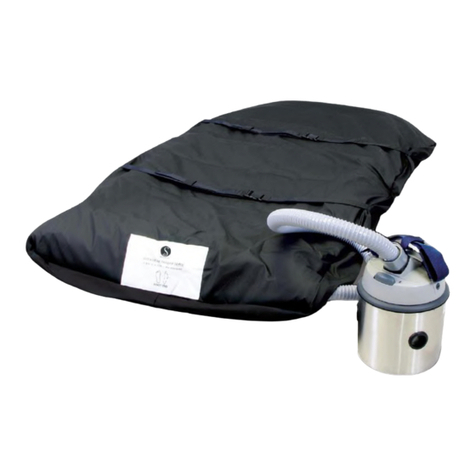
Sizewise
Sizewise ATD user manual
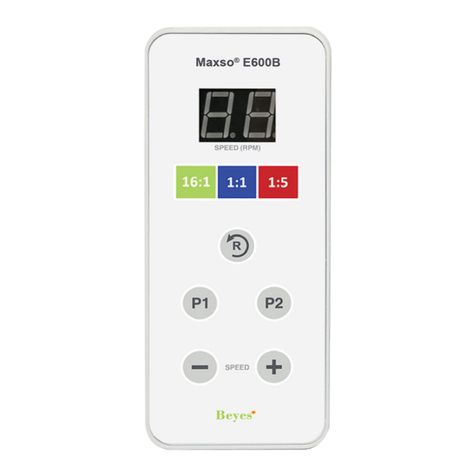
BEYES
BEYES Maxso E600B Instructions for use
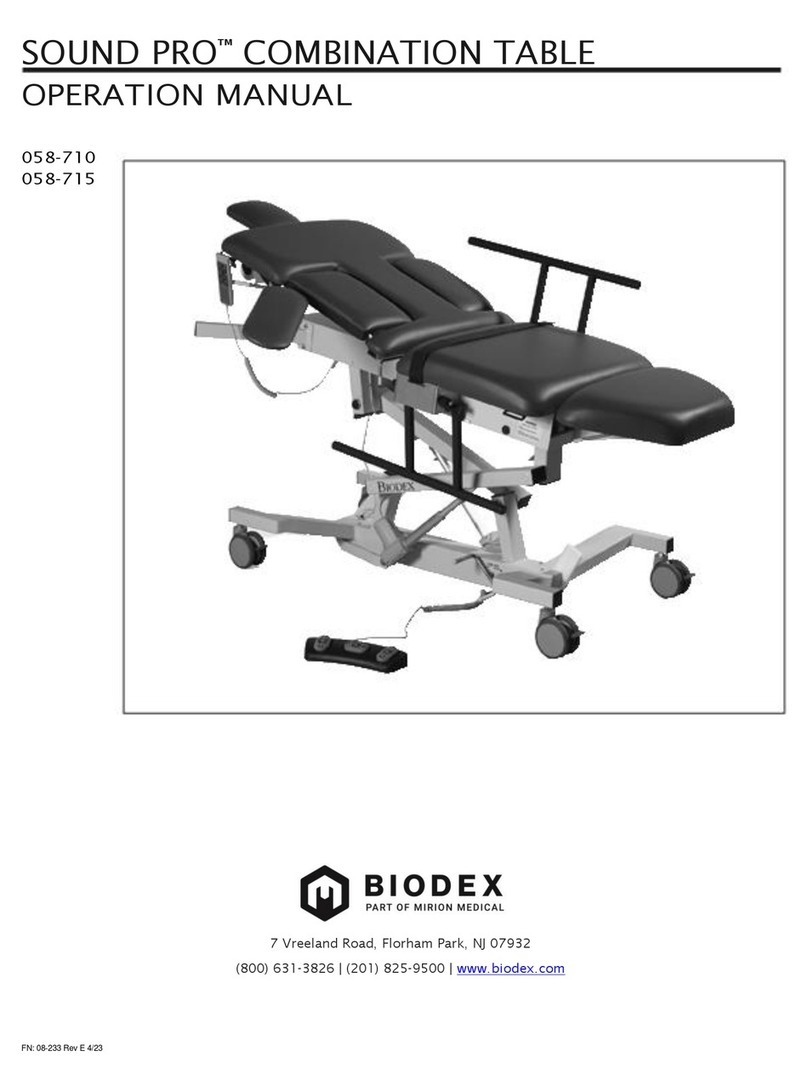
Mirion Technologies
Mirion Technologies BIODEX SOUND PRO 058-710 Operation manual
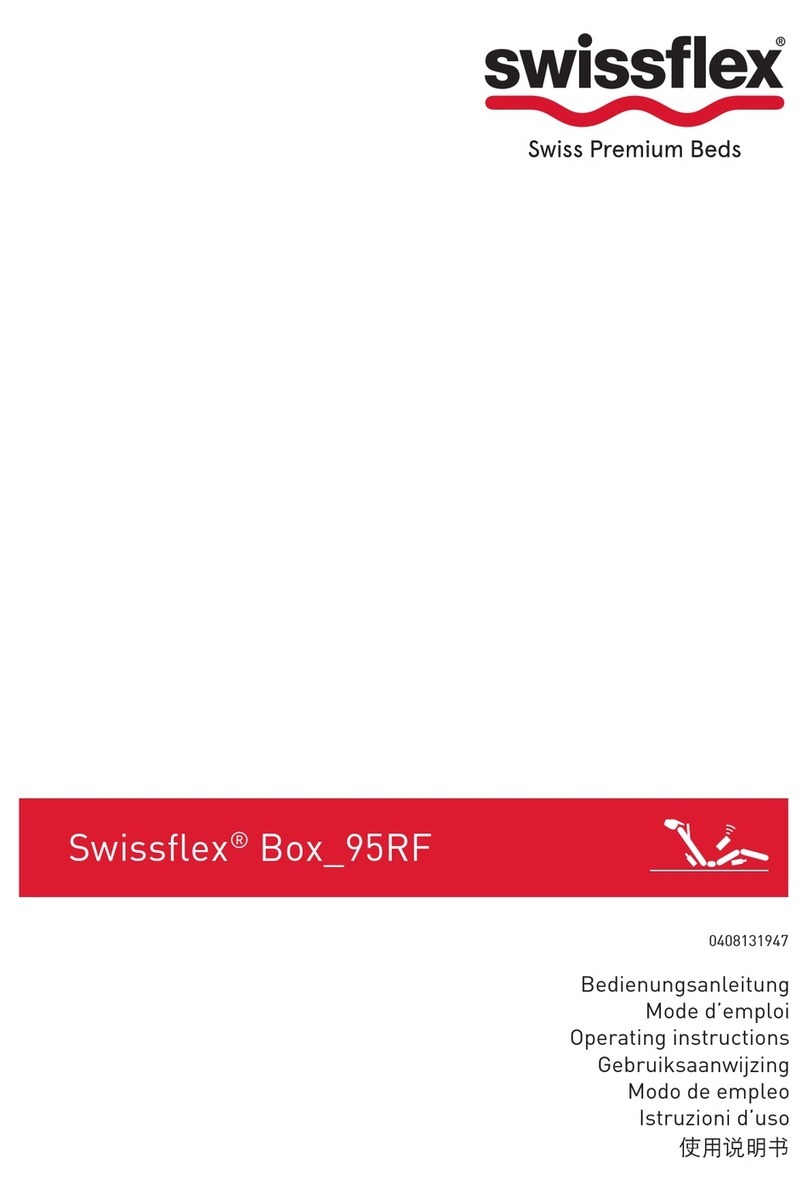
swissflex
swissflex Box 95RF operating instructions

Jaco
Jaco Ultralite Power Blade Hot-Swap 300 Series manual

Drive DeVilbiss Healthcare
Drive DeVilbiss Healthcare iGo 2 manual
